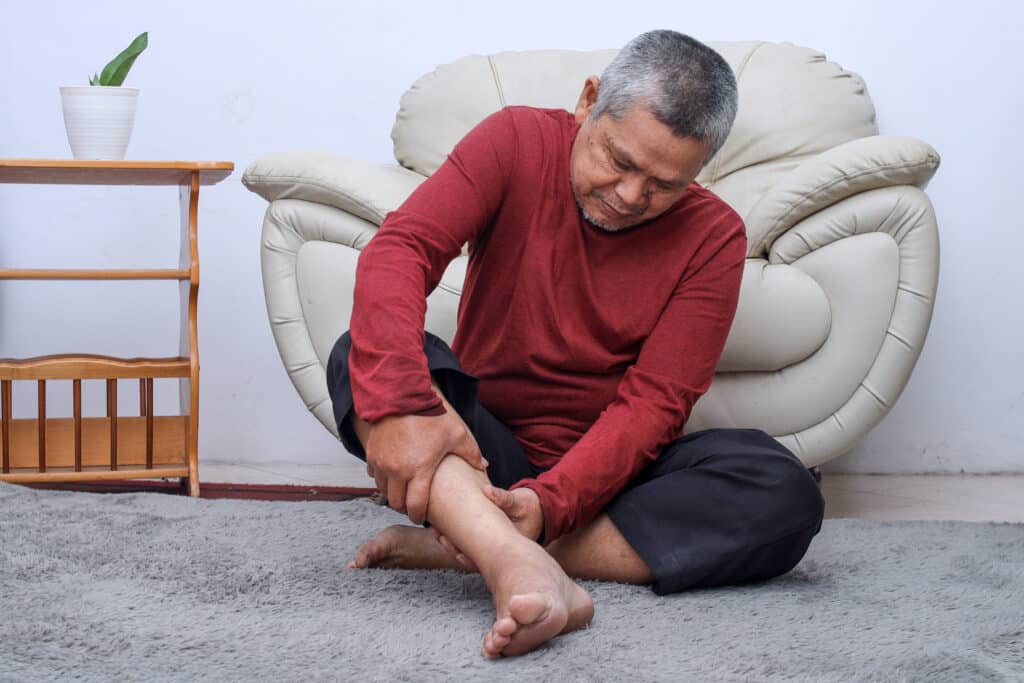Neuropathy, a condition caused by damaged nerves, often presents perplexing symptoms that can disrupt daily life. Its origins are varied, stemming from a number of conditions or injuries.
Table of Contents
- An Overview of Neuropathy
- Exploring the Many Causes of Neuropathy
- Common Types of Neuropathy
- Neuropathy Related to Cancer Treatment
- Symptoms of Neuropathy
- The Role of Diet and Exercise in Neuropathy Prevention
- The Influence of Genetics and Age on Neuropathy Risk
- Understanding Neuropathy Treatments
- Living with Neuropathy: A Manageable Challenge
- Key Takeaways
- FAQs
Understanding the underlying cause is crucial to seeking appropriate treatment, which may range from medication and lifestyle adjustments to specific therapies.
In this article, we delve into the signs, causes, and treatment options for neuropathy, aiming to provide clarity and relief for patients of all ages who might be affected by this condition.
An Overview of Neuropathy
The nervous system is a complex network of nerves that conducts tiny electrical pulses, sending signals to and from the spine and brain. Similarly to a radio signal, the nervous system can experience disruptions akin to static interference. Nerves, comparable to electrical wires, relay crucial messages between the brain and various body parts, allowing us to feel sensations, move, and regulate bodily functions.
Neuropathy is a condition that negatively affects the nerves in the trunk and limbs, causing various symptoms, including pain, weakness, tingling, and numbness.
As we age, our nerves become more prone to damage, leading to some of these uncomfortable symptoms. The feeling of pins and needles in your hands or feet or the discomfort of any form of pain are simple examples of the nervous system’s role and how it can signal a problem. These are typical experiences for individuals grappling with neuropathy.
The implications of neuropathy go beyond mere discomfort. It can interfere with daily life, impacting mobility, coordination, and even the capacity to sense temperature and touch. Neuropathy is not merely a physical challenge; it’s a condition that can significantly alter one’s quality of life.
Gaining a comprehensive understanding of neuropathy and its root causes is the initial step in identifying effective management methods. By thoroughly exploring this condition, we can arm ourselves with the necessary knowledge and tools to overcome its challenges and work towards a future free from pain and full of mobility.
Exploring the Many Causes of Neuropathy
Several things can trigger neuropathy. For example, conditions like carpal tunnel syndrome directly impact the nerves, and nerve damage due to injuries can lead to neuropathy. These conditions can cause physical compression or harm to the essential nerves in your hand, resulting in several symptoms.
Moreover, conditions like diabetes, which are more prevalent in older adults, can heighten the risk of neuropathy, particularly diabetic neuropathy. While aging is inevitable, we can take steps to manage and mitigate the effects of conditions like neuropathy, and exercise can help.
The development of neuropathy occurs due to nerve damage and the disruption of nerve signals. This damage can stem from various factors. Here are some of the most commonly cited causes of neuropathic conditions.
Nerve Damage
Neuropathy originates when nerves or parts of the nerve are damaged, often due to previous injuries or surgeries. As mentioned, nerves are vital for transmitting messages between the brain and the rest of the body. When these nerves become injured or compromised, the brain-to-body signal transmission can be disrupted.
Demyelination
Myelin is a protective covering similar to the rubber casing on an electrical wire. It insulates and protects the nerve.
Unfortunately, myelin can be damaged or destroyed in a process called demyelination. This leads to a slowdown in nerve function, causing issues with muscle control and sensation.
Metabolic Factors
High blood sugar levels, commonly seen in diabetes, can directly damage nerves through metabolic processes.
Chronic elevated blood sugar levels can harm nerve cells and their blood vessels, contributing to neuropathy.
Inflammation
Neuropathy can sometimes be associated with inflammation, either due to autoimmune conditions like rheumatoid arthritis or lupus or infections. Inflammation can damage nerves and disrupt their normal functioning.
Toxic Substances
Contact with certain toxins, such as heavy metals, industrial chemicals, or specific medications, can directly harm nerve cells, leading to neuropathy.
There are many ways that neuropathy can appear in the body. It’s a complex condition that may require different approaches to diagnosis and treatment based on its specific cause.
In the next section, we’ll look at some of the most common types of neuropathy.
Please note: like most serious illnesses, it’s best to discuss your neuropathy with your doctor or neurologist before assuming the cause of your pain.
Common Types of Neuropathy

Each type of neuropathy has unique characteristics and causes, making it essential to understand these differences for accurate diagnosis and treatment.
Diabetic Neuropathy
Diabetic neuropathy is a common form of neuropathy affecting individuals with diabetes. High blood sugar levels, a common trait of diabetes, can cause significant damage to the body’s sensitive nerve fibers.2
Peripheral Neuropathy
This is the most frequently occurring form, primarily impacting the feet and legs. Symptoms can range from pain and tingling to numbness and muscle weakness, often making walking and maintaining balance a challenge.
Autonomic Neuropathy
This form involves damage to the nerves that regulate essential bodily functions such as heart rate, digestion, and bladder function. It can result in irregular heart rhythms, digestive complications, and bladder emptying difficulties.
Proximal Neuropathy
Also referred to as diabetic amyotrophy, this form generally affects the hips, buttocks, and thighs. It can cause intense pain, muscle weakness, and difficulty standing or walking.
Related Posts
- Exercises Provide Home Remedies for Foot Neuropathy
- How the Body Balances
- Physical Therapy for Nerve Pain
- Sciatica Causes and Exercise Treatment
- The 5 Best Foot Exercises For Seniors
Focal Neuropathy
This type is defined by the sudden onset of specific nerve problems, often in the head, torso, or leg. It can result in severe pain in the affected area.
Less Common Forms of Neuropathy
Neuropathy isn’t solely linked to diabetes. In fact, various other health conditions, including alcoholism and autoimmune diseases, can also significantly increase the risk of neuropathy.
Alcohol-Related Neuropathy
Excessive alcohol use can result in nerve damage, specifically impacting the peripheral nerves. This often presents as pain and weakness in the limbs. Moderating alcohol intake is crucial for managing neuropathy and many other health conditions.
Autoimmune-Related Neuropathies
Certain autoimmune conditions, such as Guillain-Barré syndrome and chronic inflammatory demyelinating polyneuropathy (CIDP), can lead to neuropathies. These occur when the immune system erroneously targets and attacks the body’s nerves.
Idiopathic Neuropathy
At times, neuropathy may occur without any apparent cause, referred to as “idiopathic neuropathy.” This form of neuropathy can affect various types of nerves and poses a challenge in terms of diagnosis and management.
Medication or Toxin-Induced Neuropathy
Some medications and toxins can negatively affect the nerves, resulting in neuropathy. Be mindful of these potential risks. Discussing any concerns or possible alternatives with your healthcare provider is essential when considering any new treatment method or chemical exposure.
Identifying the specific type of neuropathy is a critical step in determining the most effective treatment and management strategies. Self-diagnosis could miss crucial details. Talk to your doctor to develop a comprehensive care plan for your needs.
Neuropathy Related to Cancer Treatment
Neuropathy can also be a side effect of cancer treatment. Some cancer patients may develop a condition known as chemotherapy-induced peripheral neuropathy (CIPN), which impacts the nerves in various body parts, including the hands.
CIPN is often a side effect of specific chemotherapy drugs such as taxanes and platinum compounds. While CIPN can affect different areas, including the feet and legs, it frequently manifests in the hands. Many patients visit my clinic for physical therapy during or after their cancer treatments due to persistent neuropathy symptoms.3
The precise cause of CIPN is not fully understood. Still, it’s believed to stem from damage to the peripheral nerves by chemotherapy drugs. The symptoms of CIPN can mimic those of other forms of neuropathy, including tingling, numbness, weakness, and pain in the hands.
It’s essential for cancer patients undergoing chemotherapy to be aware of the potential risk of CIPN and to discuss any symptoms they experience with their healthcare team promptly. Managing CIPN often involves a combination of strategies, including dose adjustments, switching to alternative medications, and, in some instances, physical therapy and hand exercises.
PT-prescribed exercises can help improve hand function and alleviate discomfort associated with CIPN, providing cancer patients with a way to enhance their quality of life during and after treatment.
Symptoms of Neuropathy

Neuropathy can present itself in a variety of ways. The symptoms can span from mild inconvenience to severe disability. Here are some common signs and symptoms that people with neuropathy often experience.2
Neuropathy Symptoms
- Tingling: A “pins and needles” sensation might be constant or occasional and is often reported in the wrist, ankles, hands, and feet.
- Numbness: a loss of sensation in the affected area can hinder tasks that require fine motor skills. Numbness may worsen balance issues, increasing the risk of foot injuries. Since numbness is common in the feet, it is vital for those with peripheral neuropathy to regularly check their feet for any unnoticed injuries that could lead to infection. Comfortable, supportive shoes are also highly recommended.
- Weakness: Neuropathy can result in muscle weakness in the affected area. In the case of neuropathy in the hands, this may make it challenging to grip objects, open jars, or perform other tasks that require hand strength.
- Burning Pain: Some individuals may experience constant or intermittent burning or shooting pain in the affected area.
- Sensitivity to Touch: Neuropathy can make your body hypersensitive to touch, making even light contact uncomfortable. This hypersensitivity can make ordinarily non-painful sensations feel painful.
- Loss of Coordination: Neuropathy can also lead to a loss of coordination and a decline in balance. This can make tasks like buttoning a shirt or typing more complicated and can also increase the risk of falls.
Early recognition and management of these symptoms can prevent further problems. In some cases, targeted exercises designed explicitly for neuropathy can be an effective tool in managing these symptoms.
The Role of Diet and Exercise in Neuropathy Prevention
A balanced diet, rich in specific nutrients, plays a crucial role in both the prevention and management of neuropathy.
Regular intake of vitamins B12, B6, and E, as well as essential minerals such as calcium and magnesium, are critical for nerve health. Deficiency in these nutrients can lead to nerve damage or neuropathy.
In addition to diet, regular exercise and physical activity also contribute to preventing neuropathy. Physical activity improves blood circulation, which in turn promotes nerve health. It also aids in maintaining a healthy weight and managing conditions like diabetes, a significant risk factor for neuropathy.
Exercise can also enhance balance and coordination, thus reducing the risk of falls and injuries, which can worsen neuropathy-related issues.
Incorporating a regular exercise routine into your daily life can be a potent preventative measure against neuropathy and its complications.4
The Influence of Genetics and Age on Neuropathy Risk

With age, the risk of developing neuropathy increases. Over time, the body’s ability to maintain nerve health may decrease. Also, age-related conditions like diabetes and circulation issues become more prevalent, increasing neuropathy risk.
Genetics and family history can affect an individual’s risk of developing neuropathy. If you have a family history of neuropathy, you may be more susceptible to this condition.
Being aware of your family’s medical history is crucial in identifying these genetic risks and taking steps to manage them. Regular medical check-ups and open discussions with healthcare providers can help tailor a preventative approach suited to your genetic profile.
Gender may also influence your chances of getting neuropathy, with men at a slightly higher risk.
Recognizing the impact of age and gender on neuropathy risk is vital. Proactively addressing these factors through healthier lifestyle choices, regular medical check-ups, and staying informed about potential risk factors can help.
Understanding Neuropathy Treatments
Remember that neuropathy can often be managed with the help of your doctor. Treatments can range from medications and physical therapy to lifestyle modifications.
Here are some of the most commonly recommended treatments for this condition.
Pain Relievers
For mild to moderate neuropathic pain, over-the-counter pain relievers such as acetaminophen and nonsteroidal anti-inflammatory drugs (NSAIDs) may provide some relief.
Prescription Medications
If you’re experiencing more intense pain, your healthcare provider may prescribe medications such as tricyclic antidepressants, anticonvulsants, or opioids.
Alongside certain topical medications, these drugs can help manage your pain and enhance your quality of life.
Physical Therapy
PT is a valuable tool that uses exercises and therapeutic techniques to boost muscle strength, flexibility, and balance. This can be particularly beneficial for those with neuropathy affecting their movement and coordination.
In addition to improving your range of motion and functional abilities, physical therapy can—in some cases—reduce neuropathy symptoms.
Orthopedic conditions like carpal tunnel syndrome, for instance, can lead to neuropathy symptoms that physical therapy and targeted exercises can effectively manage or even alleviate.
Transcutaneous Electrical Nerve Stimulation (TENS)
TENS therapy is a technique that uses a device to deliver low-level electrical currents to the affected area. This can help soothe the pain and discomfort associated with neuropathy.
Lifestyle Modifications
As mentioned previously, changes in diet, weight management, and regular exercise are vital in managing neuropathy. This is especially true when neuropathy is related to conditions like diabetes.
Intravenous Immunoglobulin (IVIg)
For cases of autoimmune neuropathies, IVIg may be used to suppress the immune response, which can help to reduce nerve damage.
Consultation with a healthcare provider is critical to determining the most appropriate treatment plan for your neuropathy. Effective management often involves a combination of these treatment options to address both the symptoms and underlying causes, with the ultimate goal of improving your quality of life.
Living with Neuropathy: A Manageable Challenge
While living with neuropathy presents challenges, remember that many individuals successfully manage their symptoms and lead fulfilling lives. This is possible through lifestyle modifications, carefully prescribed medication regimens, and tailored physical therapy programs.
The influence of neuropathy on your day-to-day life can range significantly, influenced by factors such as the specific type of neuropathy you have, its severity, how early it was detected, and how effectively it’s being managed.
For many people, neuropathy can cause discomfort, pain, and difficulties with mobility and coordination. However, it’s essential to understand that neuropathy doesn’t have to dictate your life’s quality. With the proper care and proactive management, you can alleviate symptoms and improve your mobility, paving the way for a more comfortable and active life.
Key Takeaways
- Neuropathy affects nerves, causing pain, weakness, tingling, and numbness.
- Aging increases the risk of nerve damage and neuropathy.
- It disrupts daily life, affecting movement and sensation.
- Causes include physical nerve damage, demyelination, metabolic issues, inflammation, and toxins.
- Common types are diabetic neuropathy and chemotherapy-induced peripheral neuropathy (CIPN).
- Alcoholism and autoimmune diseases like Guillain-Barré syndrome can also lead to neuropathy.
- Symptoms include tingling, numbness, muscle weakness, pain, sensitivity to touch, and loss of coordination.
- Vitamins B12, B6, E, calcium, and magnesium are vital for nerve health.
- Exercise improves circulation and nerve health, aiding in neuropathy prevention.
- Genetic and age factors, as well as gender, influence neuropathy risk.
- Treatments range from pain relievers, prescription meds, and physical therapy to lifestyle changes and TENS therapy.
- Managing neuropathy is possible with medical support and lifestyle adjustments.
- Quality of life can be maintained with proper treatment and management.
FAQs
Is neuropathy reversible in adults over 50?
Neuropathy can sometimes be reversible, depending on the underlying cause. For example, neuropathy caused by a vitamin deficiency can often be treated with vitamin supplements and improved diet.
However, in cases where nerve damage is extensive or due to chronic conditions, such as diabetes, it might not be fully reversible, but symptoms can often be managed effectively.
What lifestyle changes can help manage neuropathy?
Lifestyle changes that can help manage neuropathy include maintaining a healthy weight, following a balanced diet rich in vitamins and minerals, avoiding excessive alcohol consumption, quitting smoking, and engaging in regular, gentle exercises like walking, swimming, or yoga to improve circulation and muscle strength.
Are there any specific exercises recommended for those with neuropathy?
Yes, exercises focusing on balance and strength can be beneficial, such as low-impact aerobic activities, gentle stretching, and strength training. Always consult a healthcare provider or physical therapist to create a safe and effective exercise plan.
Is it safe for someone with neuropathy to continue being physically active?
Physical activity is generally encouraged because it can improve overall health and reduce neuropathy symptoms. However, it’s important to choose low-impact activities to avoid foot injuries and to wear appropriate footwear. Check with your doctor to ensure your exercise plan is safe for your condition.
Can physical therapy help with neuropathy, and if so, how?
Yes, physical therapy can be a vital part of managing neuropathy. A physical therapist can develop a tailored exercise program focusing on reducing pain, improving muscle strength, maintaining balance, and increasing range of motion.
Therapeutic exercises can also enhance blood flow to the nerves, which may help slow the progression of nerve damage. Additionally, physical therapists can teach techniques for safer movements and activities of daily living, which can help reduce the risk of falls and injuries.
References
- Allen, M. D., Doherty, T. J., Rice, C. L., & Kimpinski, K. (2016). Physiology in Medicine: neuromuscular consequences of diabetic neuropathy. Journal of Applied Physiology, 121(1), 1-6.
- Khdour, M. R. (2020). Treatment of diabetic peripheral neuropathy: a review. Journal of Pharmacy and Pharmacology, 72(7), 863-872.
- Hu, L. Y., Mi, W. L., Wu, G. C., Wang, Y. Q., & Mao-Ying, Q. L. (2019). Prevention and treatment for chemotherapy-induced peripheral neuropathy: therapies based on CIPN mechanisms. Current neuropharmacology, 17(2), 184-196.
- Smith, A. G., Russell, J., Feldman, E. L., Goldstein, J., Peltier, A., Smith, S., … & Singleton, J. R. (2006). Lifestyle intervention for pre-diabetic neuropathy. Diabetes care, 29(6), 1294-1299.







